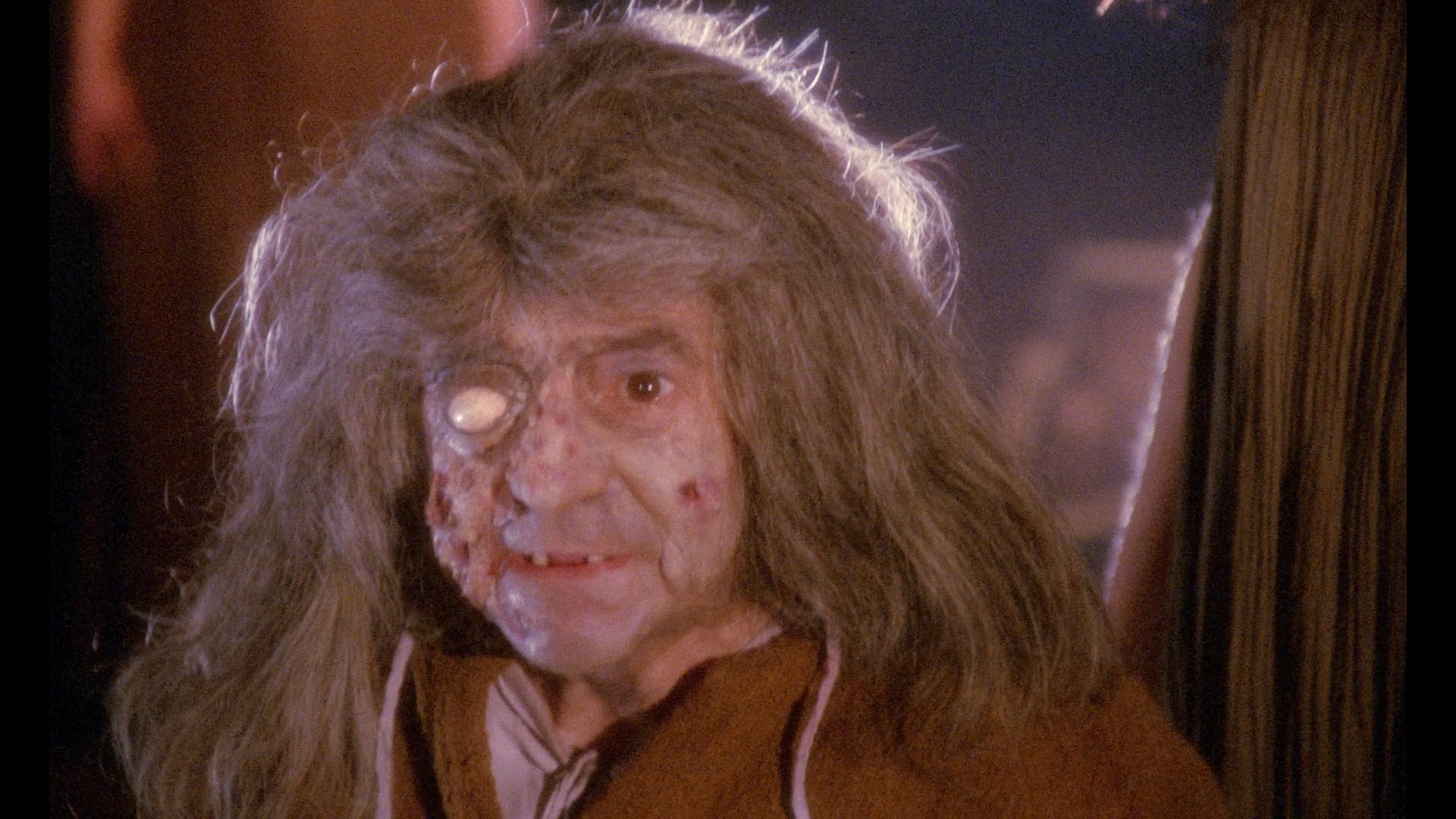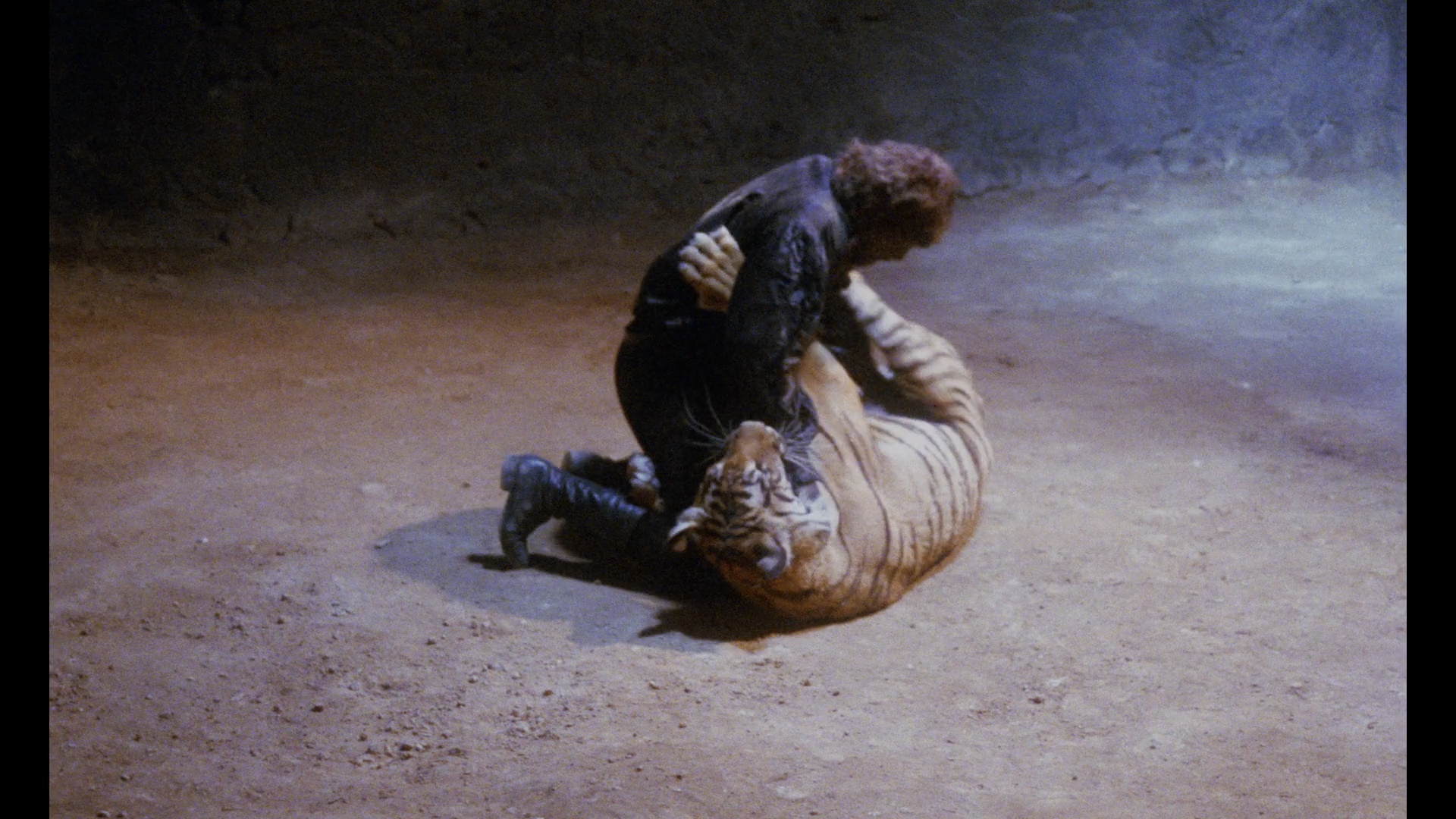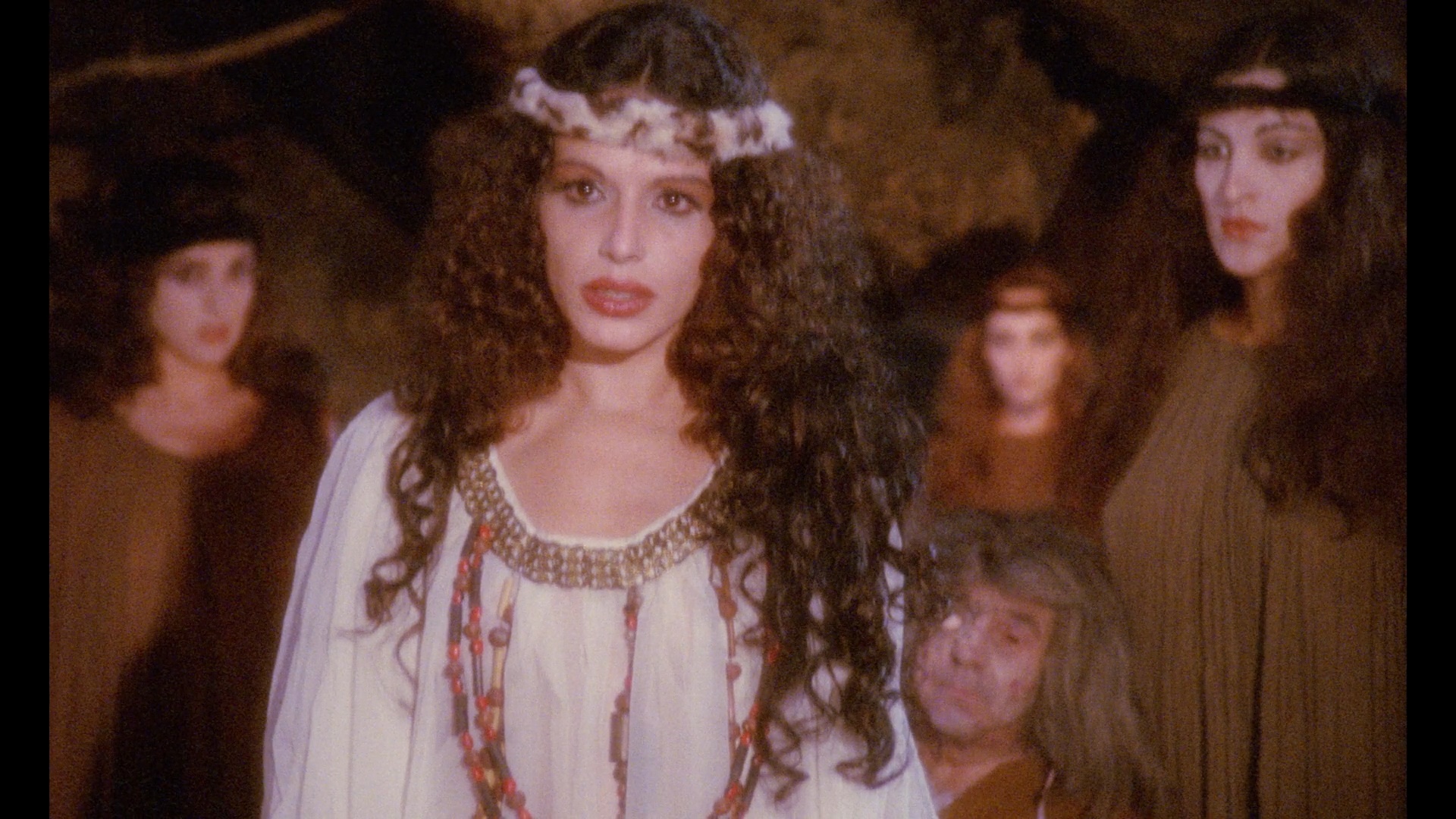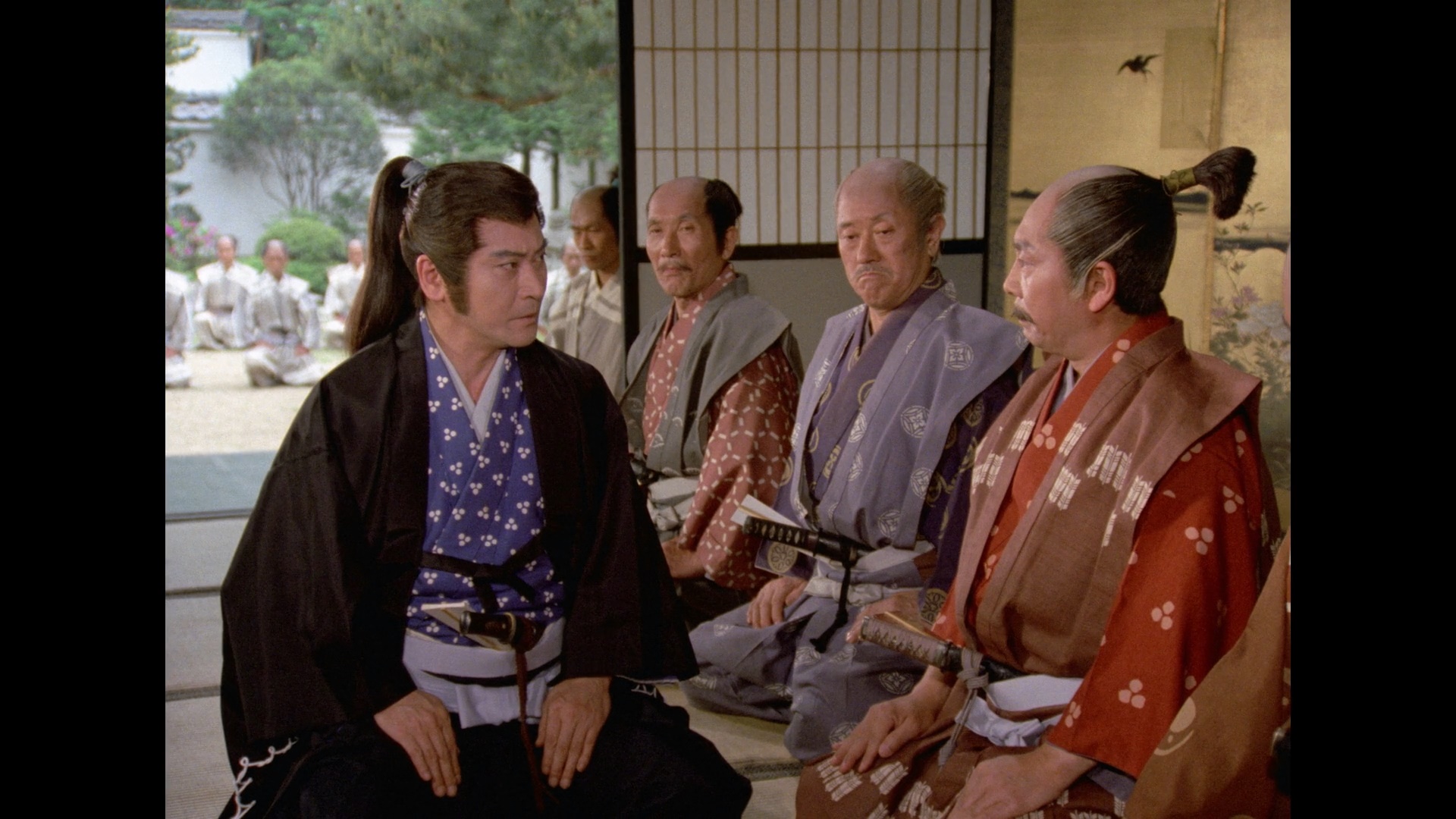

Color, 1983, 114 mins. 59 secs.
Directed by Jacinto Molina
Starring Paul Naschy, Shigeru Amachi, Beatriz Escudero, Junko Asahina, Violeta Cela, Gerard Tichy
Mondo Macabro (Blu-ray) (US R0 HD) / WS (1.66:1) (16:9)
After  a string of films about the tormented werewolf Waldemar Daninsky,
a string of films about the tormented werewolf Waldemar Daninsky,  star and sometimes writer-director Paul Naschy had firmly established his most famous character without setting up much continuity between entries. Exactly where this one falls in the cycle depends on how you're counting the films (it could be anywhere from the ninth to the eleventh), but it definitely marked a huge change of pace after the purely Spanish Night of the Werewolf, better known to U.S. theatergoers as The Craving. With financing drying up into the 1980s, Naschy found an unexpected source of funding Japan starting with 1980's grim Human Beasts. With The Beast and the Magic Sword, Naschy relocated his most famous monster to Japan and got to indulge in some of the most lavish costumes and sets of his career, not to mention a stable of fresh new acting talent thanks to the Japanese thespians at his disposal. However, the film was only shown theatrically in Spain and became a peculiar footnote in Naschy's career mentioned far more often than actually seen. An English dub was never commissioned, and until the 2020 Blu-ray release from Mondo Macabro, it was never even officially subtitled for English-speaking viewers.
star and sometimes writer-director Paul Naschy had firmly established his most famous character without setting up much continuity between entries. Exactly where this one falls in the cycle depends on how you're counting the films (it could be anywhere from the ninth to the eleventh), but it definitely marked a huge change of pace after the purely Spanish Night of the Werewolf, better known to U.S. theatergoers as The Craving. With financing drying up into the 1980s, Naschy found an unexpected source of funding Japan starting with 1980's grim Human Beasts. With The Beast and the Magic Sword, Naschy relocated his most famous monster to Japan and got to indulge in some of the most lavish costumes and sets of his career, not to mention a stable of fresh new acting talent thanks to the Japanese thespians at his disposal. However, the film was only shown theatrically in Spain and became a peculiar footnote in Naschy's career mentioned far more often than actually seen. An English dub was never commissioned, and until the 2020 Blu-ray release from Mondo Macabro, it was never even officially subtitled for English-speaking viewers.
Our fantastic tale begins in a time "when magic was in the air" in 938 A.D. with a new origin story for Waldemar, as an Emperor and a Bishop are in search of a Polish paladin to face  the demonic Hungarian warrior Bulcho who is tied to a decreed curse on the land thanks to his witch girlfriend. Daninsky's ancestor is called in for the fateful duel,
the demonic Hungarian warrior Bulcho who is tied to a decreed curse on the land thanks to his witch girlfriend. Daninsky's ancestor is called in for the fateful duel,  which leads to a curse on his family via a particularly grotesque application of a wolf skull. Five centuries later, Waldemar is trying to cure his lycanthrophic curse with the aid of a secret alchemist's sect, but that quickly goes south and sends Waldemar in search of the only other possible magic practitioner who can help him: Kian (The Ghost of Yotsuya's Amachi), who of course lives in feudal Kyoto. Accompanied by the blind Esther (Cela), Waldemar makes the journey but of course starts ripping up the locals when the full moon strikes. Kian quickly deduces who's to blame and decides to seek more help from a reclusive witch... which turns out to be a major obstacle in helping our poor werewolf protagonist.
which leads to a curse on his family via a particularly grotesque application of a wolf skull. Five centuries later, Waldemar is trying to cure his lycanthrophic curse with the aid of a secret alchemist's sect, but that quickly goes south and sends Waldemar in search of the only other possible magic practitioner who can help him: Kian (The Ghost of Yotsuya's Amachi), who of course lives in feudal Kyoto. Accompanied by the blind Esther (Cela), Waldemar makes the journey but of course starts ripping up the locals when the full moon strikes. Kian quickly deduces who's to blame and decides to seek more help from a reclusive witch... which turns out to be a major obstacle in helping our poor werewolf protagonist.
Despite its indulgent running time of just under two hours, this one is a sheer blast of horror-action entertainment from start to finish. You get a snarling witch and a disfigured dwarf in the first few minutes, and that's just a prelude for one feisty set piece after another including a spectacularly vicious werewolf attack in a geisha house and one of the greatest moments of any Naschy film, a full-on wrestling match between Waldemar in werewolf mode and a real Bengal tiger. By this point Naschy (who also handled  some Japanese TV documentaries about Spanish culture to help pay for these projects) had been directing most of his own projects since the late '70s and helmed this one back to
some Japanese TV documentaries about Spanish culture to help pay for these projects) had been directing most of his own projects since the late '70s and helmed this one back to  back with the wild Panic Beats the same year, and he does a fine job handling the opulent period setting and unusually high number of action sequences including some fun samurai action in the second half. It takes a while to get used to the spectacle of Japanese actors dubbed in Spanish, but it's worth the investment with Amachi in particular giving a solid performance that essentially qualifies him as the other lead.
back with the wild Panic Beats the same year, and he does a fine job handling the opulent period setting and unusually high number of action sequences including some fun samurai action in the second half. It takes a while to get used to the spectacle of Japanese actors dubbed in Spanish, but it's worth the investment with Amachi in particular giving a solid performance that essentially qualifies him as the other lead.
Due to its limited distribution in theaters and then on home video, this has been one of the most frustrating Naschy films to find in anything resembling decent quality. It's been a gray market staple for a while if you dug around enough, but that was still a terrible way to experience a film so heavily reliant on its ornate visual details. Fortunately the Mondo Macabro release makes up for that decades-long neglect with a sterling new presentation listed as a 4K transfer of the negative; colors look gorgeous and the once inscrutable darker scenes are now very detailed and atmospheric. It's worth nothing that one of the cameras during the production appears to have had a defect as some shots (mainly in the prologue) have a registration issue with bright edges on the screen, similar to that one funky camera used on The Bad Seed. In any case, don't fret when you see it at the beginning as that in-camera imperfection doesn't last long and only appears in some intermittent shots. In an interesting move, the film is presented in two aspect ratios: the open matte 1.33:1 version previously issued on VHS (which looks compositionally similar to a lot of the other opened-up 1.33:1  Naschy films around on Blu-ray), and a matted 1.66:1 option that an opening disclaimer notes is believed by Mondo Macabro to be the correct framing. Try both and see which one you
Naschy films around on Blu-ray), and a matted 1.66:1 option that an opening disclaimer notes is believed by Mondo Macabro to be the correct framing. Try both and see which one you  prefer; some comparison grabs can be seen below. The DTS-HD MA Spanish mono track sounds excellent (given the very flat nature of the original sound mix anyway) and has optional English subtitles. An audio commentary with NaschyCast's Rod Barnett and Troy Guinn is very enthusiastic and informative, as you'd expect, with tons of information about Naschy's career at the time, the Japanese financing, the period props and costumes, the backgrounds of the actors, and the history behind the film's release (or general lack thereof). In a video introduction to the film by Naschy (13m36s), he talks about the film as one of his best and an "enormous responsibility" given the international expectations involved at the time, as well as the generous accommodations made to keep the film's story set in the correct time period for which it was written (including the memorable katana). He also explains how they pulled off that amazing tiger fight, which involved an animal star from the popular Italian series Sandokan. A new interview with Gavin Baddeley (32m12s), author of The FrightFest Guide to Werewolf Movies, is a thorough analysis of the appeal of Naschy's cinema including the influence of a pivotal viewing of Frankenstein Meets the Wolf Man, the obstacles Naschy faced after the werewolf cinematic renaissance in 1981, the use of monster makeup effects, and the balance of ego and artistry required for Naschy's horror movie balancing act. The archival Naschy interview "The Smile of the Wolf" (46m22s) is a typically engaging chat with the late horror legend in what appears to be a dungeon as he chats about his entire career including the one lost (and presumably never completed) Daninsky feature, the Universal monster influence, the development of his lycanthropic appearance, and lots more including his troubled experience on Assignment Terror. The rare Spanish trailer is also included.
prefer; some comparison grabs can be seen below. The DTS-HD MA Spanish mono track sounds excellent (given the very flat nature of the original sound mix anyway) and has optional English subtitles. An audio commentary with NaschyCast's Rod Barnett and Troy Guinn is very enthusiastic and informative, as you'd expect, with tons of information about Naschy's career at the time, the Japanese financing, the period props and costumes, the backgrounds of the actors, and the history behind the film's release (or general lack thereof). In a video introduction to the film by Naschy (13m36s), he talks about the film as one of his best and an "enormous responsibility" given the international expectations involved at the time, as well as the generous accommodations made to keep the film's story set in the correct time period for which it was written (including the memorable katana). He also explains how they pulled off that amazing tiger fight, which involved an animal star from the popular Italian series Sandokan. A new interview with Gavin Baddeley (32m12s), author of The FrightFest Guide to Werewolf Movies, is a thorough analysis of the appeal of Naschy's cinema including the influence of a pivotal viewing of Frankenstein Meets the Wolf Man, the obstacles Naschy faced after the werewolf cinematic renaissance in 1981, the use of monster makeup effects, and the balance of ego and artistry required for Naschy's horror movie balancing act. The archival Naschy interview "The Smile of the Wolf" (46m22s) is a typically engaging chat with the late horror legend in what appears to be a dungeon as he chats about his entire career including the one lost (and presumably never completed) Daninsky feature, the Universal monster influence, the development of his lycanthropic appearance, and lots more including his troubled experience on Assignment Terror. The rare Spanish trailer is also included.
1.66:1 VERSION





1.33:1 VERSION





Reviewed on March 5, 2020.



 a string of films about the tormented werewolf Waldemar Daninsky,
a string of films about the tormented werewolf Waldemar Daninsky,  star and sometimes writer-director Paul Naschy had firmly established his most famous character without setting up much continuity between entries. Exactly where this one falls in the cycle depends on how you're counting the films (it could be anywhere from the ninth to the eleventh), but it definitely marked a huge change of pace after the purely Spanish Night of the Werewolf, better known to U.S. theatergoers as The Craving. With financing drying up into the 1980s, Naschy found an unexpected source of funding Japan starting with 1980's grim Human Beasts. With The Beast and the Magic Sword, Naschy relocated his most famous monster to Japan and got to indulge in some of the most lavish costumes and sets of his career, not to mention a stable of fresh new acting talent thanks to the Japanese thespians at his disposal. However, the film was only shown theatrically in Spain and became a peculiar footnote in Naschy's career mentioned far more often than actually seen. An English dub was never commissioned, and until the 2020 Blu-ray release from Mondo Macabro, it was never even officially subtitled for English-speaking viewers.
star and sometimes writer-director Paul Naschy had firmly established his most famous character without setting up much continuity between entries. Exactly where this one falls in the cycle depends on how you're counting the films (it could be anywhere from the ninth to the eleventh), but it definitely marked a huge change of pace after the purely Spanish Night of the Werewolf, better known to U.S. theatergoers as The Craving. With financing drying up into the 1980s, Naschy found an unexpected source of funding Japan starting with 1980's grim Human Beasts. With The Beast and the Magic Sword, Naschy relocated his most famous monster to Japan and got to indulge in some of the most lavish costumes and sets of his career, not to mention a stable of fresh new acting talent thanks to the Japanese thespians at his disposal. However, the film was only shown theatrically in Spain and became a peculiar footnote in Naschy's career mentioned far more often than actually seen. An English dub was never commissioned, and until the 2020 Blu-ray release from Mondo Macabro, it was never even officially subtitled for English-speaking viewers.  the demonic Hungarian warrior Bulcho who is tied to a decreed curse on the land thanks to his witch girlfriend. Daninsky's ancestor is called in for the fateful duel,
the demonic Hungarian warrior Bulcho who is tied to a decreed curse on the land thanks to his witch girlfriend. Daninsky's ancestor is called in for the fateful duel,  which leads to a curse on his family via a particularly grotesque application of a wolf skull. Five centuries later, Waldemar is trying to cure his lycanthrophic curse with the aid of a secret alchemist's sect, but that quickly goes south and sends Waldemar in search of the only other possible magic practitioner who can help him: Kian (The Ghost of Yotsuya's Amachi), who of course lives in feudal Kyoto. Accompanied by the blind Esther (Cela), Waldemar makes the journey but of course starts ripping up the locals when the full moon strikes. Kian quickly deduces who's to blame and decides to seek more help from a reclusive witch... which turns out to be a major obstacle in helping our poor werewolf protagonist.
which leads to a curse on his family via a particularly grotesque application of a wolf skull. Five centuries later, Waldemar is trying to cure his lycanthrophic curse with the aid of a secret alchemist's sect, but that quickly goes south and sends Waldemar in search of the only other possible magic practitioner who can help him: Kian (The Ghost of Yotsuya's Amachi), who of course lives in feudal Kyoto. Accompanied by the blind Esther (Cela), Waldemar makes the journey but of course starts ripping up the locals when the full moon strikes. Kian quickly deduces who's to blame and decides to seek more help from a reclusive witch... which turns out to be a major obstacle in helping our poor werewolf protagonist. some Japanese TV documentaries about Spanish culture to help pay for these projects) had been directing most of his own projects since the late '70s and helmed this one back to
some Japanese TV documentaries about Spanish culture to help pay for these projects) had been directing most of his own projects since the late '70s and helmed this one back to  back with the wild Panic Beats the same year, and he does a fine job handling the opulent period setting and unusually high number of action sequences including some fun samurai action in the second half. It takes a while to get used to the spectacle of Japanese actors dubbed in Spanish, but it's worth the investment with Amachi in particular giving a solid performance that essentially qualifies him as the other lead.
back with the wild Panic Beats the same year, and he does a fine job handling the opulent period setting and unusually high number of action sequences including some fun samurai action in the second half. It takes a while to get used to the spectacle of Japanese actors dubbed in Spanish, but it's worth the investment with Amachi in particular giving a solid performance that essentially qualifies him as the other lead.  Naschy films around on Blu-ray), and a matted 1.66:1 option that an opening disclaimer notes is believed by Mondo Macabro to be the correct framing. Try both and see which one you
Naschy films around on Blu-ray), and a matted 1.66:1 option that an opening disclaimer notes is believed by Mondo Macabro to be the correct framing. Try both and see which one you  prefer; some comparison grabs can be seen below. The DTS-HD MA Spanish mono track sounds excellent (given the very flat nature of the original sound mix anyway) and has optional English subtitles. An audio commentary with NaschyCast's Rod Barnett and Troy Guinn is very enthusiastic and informative, as you'd expect, with tons of information about Naschy's career at the time, the Japanese financing, the period props and costumes, the backgrounds of the actors, and the history behind the film's release (or general lack thereof). In a video introduction to the film by Naschy (13m36s), he talks about the film as one of his best and an "enormous responsibility" given the international expectations involved at the time, as well as the generous accommodations made to keep the film's story set in the correct time period for which it was written (including the memorable katana). He also explains how they pulled off that amazing tiger fight, which involved an animal star from the popular Italian series Sandokan. A new interview with Gavin Baddeley (32m12s), author of The FrightFest Guide to Werewolf Movies, is a thorough analysis of the appeal of Naschy's cinema including the influence of a pivotal viewing of Frankenstein Meets the Wolf Man, the obstacles Naschy faced after the werewolf cinematic renaissance in 1981, the use of monster makeup effects, and the balance of ego and artistry required for Naschy's horror movie balancing act. The archival Naschy interview "The Smile of the Wolf" (46m22s) is a typically engaging chat with the late horror legend in what appears to be a dungeon as he chats about his entire career including the one lost (and presumably never completed) Daninsky feature, the Universal monster influence, the development of his lycanthropic appearance, and lots more including his troubled experience on Assignment Terror. The rare Spanish trailer is also included.
prefer; some comparison grabs can be seen below. The DTS-HD MA Spanish mono track sounds excellent (given the very flat nature of the original sound mix anyway) and has optional English subtitles. An audio commentary with NaschyCast's Rod Barnett and Troy Guinn is very enthusiastic and informative, as you'd expect, with tons of information about Naschy's career at the time, the Japanese financing, the period props and costumes, the backgrounds of the actors, and the history behind the film's release (or general lack thereof). In a video introduction to the film by Naschy (13m36s), he talks about the film as one of his best and an "enormous responsibility" given the international expectations involved at the time, as well as the generous accommodations made to keep the film's story set in the correct time period for which it was written (including the memorable katana). He also explains how they pulled off that amazing tiger fight, which involved an animal star from the popular Italian series Sandokan. A new interview with Gavin Baddeley (32m12s), author of The FrightFest Guide to Werewolf Movies, is a thorough analysis of the appeal of Naschy's cinema including the influence of a pivotal viewing of Frankenstein Meets the Wolf Man, the obstacles Naschy faced after the werewolf cinematic renaissance in 1981, the use of monster makeup effects, and the balance of ego and artistry required for Naschy's horror movie balancing act. The archival Naschy interview "The Smile of the Wolf" (46m22s) is a typically engaging chat with the late horror legend in what appears to be a dungeon as he chats about his entire career including the one lost (and presumably never completed) Daninsky feature, the Universal monster influence, the development of his lycanthropic appearance, and lots more including his troubled experience on Assignment Terror. The rare Spanish trailer is also included.








